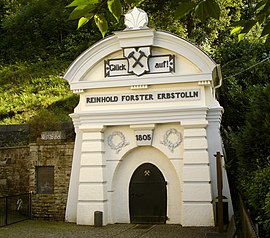Reinhold Forster Erbstollen
| Reinhold Forster Erbstollen | |||
|---|---|---|---|
| General information about the mine | |||
| Restored tunnel portal | |||
| Information about the mining company | |||
| Start of operation | March 21, 1805 | ||
| End of operation | 1902 | ||
| Funded raw materials | |||
| Degradation of | Spateisenstein | ||
| Geographical location | |||
| Coordinates | 50 ° 49 '59 " N , 7 ° 59' 3" E | ||
|
|||
| Location | Eiserfeld | ||
| local community | Wins | ||
| District ( NUTS3 ) | Siegen-Wittgenstein | ||
| country | State of North Rhine-Westphalia | ||
| Country | Germany | ||
| District | Bergrevier Siegen I | ||
The Reinhold Forster-Erbstollen is the heritage tunnel of the Eisenzecher Zug mine , whose tunnel mouth hole is located in the Eiserfeld district of Siegen . The tunnel is part of and entrance to the large network of tunnels that undermines the Eiserfeld and Eisern districts of Siegen . The tunnel was part of the Eisenzecher Zug composite mine; its tunnel mouth hole from 1879 is distinctive for the Siegerland mining industry .
history
The tunnel, which was cut on March 21, 1805, was created to loosen the Tretenbacher passages, i.e. the individual pits Eisenzeche , Kirschenbaum , Schlänger & Eichert , Scheuer , Kalteborn and others. The tunnel is named after the natural scientist and geologist Johann Reinhold Forster . From October 4, 1839 the tunnel was in royal possession, from November 5, 1842 there were inheritance rights for the "Royal Deep Reinhold Forster Erbstollen" to reach the Eisenzecher, Pfannenberger and Römeler mines. In 1865 it became the property of the Eisenzecher mines.
|
An average of 8 employees drove the tunnel with a daily advance of 3–5, later of up to 15 cm.
The tunnel met the Tretenbacher Gänge in 1842 , in 1859 on Schlänger and Eichert , in 1864 on Scheuer , in 1868 on Grauebach and in December 1883 on the Kalteborner Gang .
From the entrance of the Erbstollen to the Kaiserschacht the tunnel with a length of 7,597.5 m (including side corridors) - after the Schlebuscher Erbstollen southeast of Bochum - is one of the longest in North Rhine-Westphalia . In 1902 the company was stopped. Several hundred tons of iron ore and small amounts of copper ore were extracted during construction .
Like many other tunnels in today's Siegen city area, the tunnel served as a refuge from air raids for the citizens of Eiserfeld during the Second World War in 1944/45. There used to be conveyor systems on the Kaiserschacht, today it is used as a residential area.
The disused Reinhold Forster-Erbstollen served as an explosives store for commercial purposes until 1977 . It is accessible over a length of 470 m and has been a show mine since 1983 .
Personalities
Trades of the Erbstollen were among others:
- Johann Heinrich Steinseifer, Eiserfeld (1811)
- Johannes Hoffmann and his wife Catharina born. Hartmann, Eiserfeld (1846)
- Friedrich Stolz , Eiserfeld (1829)
See also
literature
- Horst G. Koch: Queen of the iron stone pits. - Eisenzecher Zug / Reinhold-Forster-Erbstollen , Verlag Gudrun Koch, Siegen 1986. ISBN 3-7001027-2-0
- Ute Bosbach: Searching for traces in Eisenland - On the way on ore roads and miners ' paths, amadeusmedien, November 2006. ISBN 3-9808936-8-5


